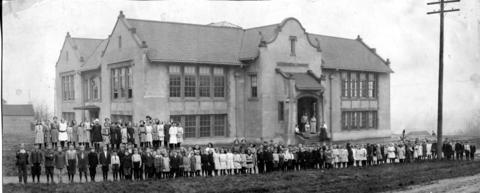Identity elements
Reference code
Name and location of repository
Level of description
Item
Title
TPL-2868
Date(s)
- 1913 (Creation)
Extent
Content and structure elements
Scope and content
ca. 1913. This is Hawthorne School shortly after opening in September of 1913. The entire population of the elementary school is lined up in front of the imposing building with Jessie Lithgow near the far right. Jessie's face has been circled and an arrow pointed toward the head. Hawthorne School was the first school in the Northwest with a German plan assembly hall. It had originated as East School in 1885 in temporary classrooms at a former store at South 24th & Pacific Ave. A new two-room building was constructed at East D & 31st streets in 1886 and classes were held with only one teacher. A six-room addition was authorized in 1889 by the school board and the school renamed Hawthorne after author Nathaniel Hawthorne. Enrollment grew with the admittance of Puyallup Indian Tribal children in 1896 and by 1904 Hawthorne was the school district's third largest school after Central and Lowell. When other schools were built in the eastern and southern parts of the city enrollment started to decline at Hawthorne in 1908. Nonetheless, a new Hawthorne School was built in 1913 at 28th & East F Sts. It held 438 students and four teachers, much smaller than Hawthorne in 1905 when enrollment reached 1,305 students. Hawthorne closed in 1963 and later the building housed early childhood education programs. For a few short years it was the Puyallup Indian Tribe's Chief Leschi School. The school was razed in June of 1981 to make way for the Tacoma Dome. (Olsen: For the Record, p. 53-54-article & various photographs)
Hawthorne School (Tacoma); Public schools--Tacoma--1910-1920; School children--Tacoma--1910-1920;

